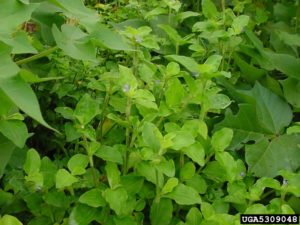Non-Native

Theodore Webster, USDA Agricultural Research Service, Bugwood.org
Commelina benghalensis
More Info & Photos of Tropical Spiderwort
Non-Herbicide Management Options
1. Physical Management Options
Tropical spiderwort can be dug up, plowing, mulching, raking and prescribed fires. However, physical control is difficult because it can re-establish from remaining plant fragments.
2. Biological Management Options
At this time, there are no known biological management options for tropical spiderwort.
Herbicide Control Options
Always read the product label for directions and precautions, as the label is the law. Click on the name of the product to see the label. Read the label for specific water use restrictions.
The active ingredients that have been successful in treating this plant include:
- Carfentrazone
- Flumioxazin
1) Carfentrazone
Carfentrazone is a contact herbicide that is absorbed through the leaves. Contact herbicides act quickly and kill all plant cells they come in contact with.
Common trade and product names include but are not limited to:
2) Flumioxazin
Flumioxazin is a water dispensable granule that is to be sprayed or injected after mixing. It is a broad spectrum, contact herbicide. Contact herbicides act quickly. Flumioxazin should be applied to actively growing plants and a surfactant (a substance that reduces water tension) will be needed if the herbicide is applied to foliage of floating or emergent plants. Water pH needs to be below 8.5 or flumioxazin will rapidly degrade and lose effectiveness.
Common trade and product names include but are not limited to:
Precautions
One danger with any chemical control method is the chance of an oxygen depletion after the treatment caused by the decomposition of the dead plant material. Oxygen depletion can kill fish in the pond. If the pond is heavily infested with weeds, it may be possible (depending on the herbicide chosen) to treat the pond in sections and let each section decompose for about two weeks before treating another section. Aeration, particularly at night, for several days after treatment may help control the oxygen depletion.
One common problem in using aquatic herbicides is determining area and/or volume of the pond or area to be treated. To assist you with these determinations see SRAC #103 Calculating Area and Volume of Ponds and Tanks.
Many aquatically registered herbicides have water use restrictions (See General Water Use Restrictions).
To see the labels for these products click on the name. Always read and follow all label directions. Check label for specific water use restrictions.
Cultivation Options
This plant is not native to North America, but has naturalized in much of the United States. While it is not illegal to possess this plant in Texas, it should not be introduced into new water bodies and should be treated with herbicide when present.
Questions?
If you need assistance, contact the Ag & Natural Resources agent in your county or hire a professional.